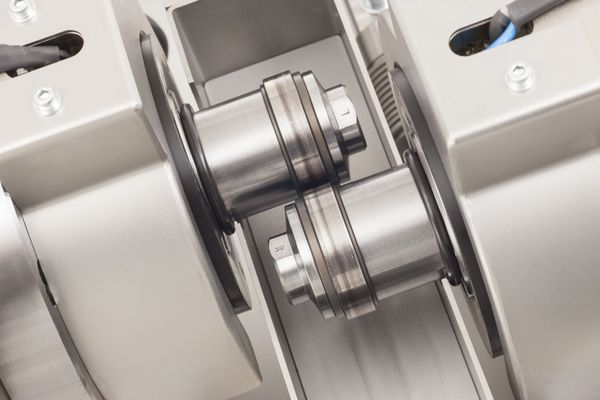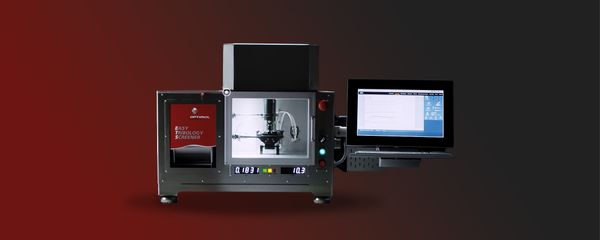
Further Tribology Test Equipment
The perfect addition to our range of tribological systems.
Standard-Compliant Testing Using the Right Tribological Measuring Instrument
Analyses in the petrochemical industry comprise a large number of specific standard methods. Standard tests, ASTM, ISO, DIN, IP and related international standard methods require their own analysis systems. A comprehensive range of manual and automatic instruments for lubricant and oil laboratories as well as standards and accessories to meet these testing requirements can be found here.
Oscillating Rolling Wear Test Bench (SNR-FEB2)

In the false brinelling test rig, the wear protection behavior of lubricating greases in rolling bearings is tested, which are only operated with small swivel angles.
The best known is the SNR-FEB2 test which is required, for example, for greases in the pitch bearings of wind turbines (swing angle +/- 3°). KTM has also developed a laboratory standard test that can be used to simulate bearings that are subjected to only very small swiveling movements or even vibrations (+/- 0.5°).
The bearings are weighed before and after the test. In addition, the wear marks in the barrel rings are inspected and measured.
The test rig at KTM also allows tests with liquid lubricants. Tapered roller bearings can also be tested using an adapter. In addition, the test bearings can be cooled down to low temperatures with a cooling unit.
| Axial force | 100 to 8,000 N |
| Test duration | 1 min; 6 min; 1.3 h; SNR test 50 h |
| Oscillation frequency | Stepless 1 to 40 Hz (standard 25 Hz) |
| Oscillation angle | 0.2 to +/-3° (SNR standard +/- 3°; KTM standard +/- 0.5°) |
| Temperature | -20 to 80°C (standard RT) |
| Test bearing | Thrust ball bearing type 51206 , KRL optional |

The adjacent bidl shows a typical standstill marking with the inner, unchanged adhesion zone. The damage occurs in the areas with microslip. Here, unsuitable lubricants quickly cause massive damage as a result of adhesion and disruption.
- SNR-FEB2 test (standard test for grease for blade bearings of wind turbines)
- Quasi-still test according to globally accepted laboratory standard (QSST)
- Influence of liquid or paste lubricants on vibratory rolling element wear
- Influence of ambient temperature on the development of false brinelling damage
Cross Cylinder Tester (XCT)



The cross-cylinder tester (XCT) developed at the Tribology Competence Center combines the Reichert-Reibverschleisswaage (RVW) and the Brugger tester and is used to investigate and simulate friction and wear processes under continuous sliding stress in solid, boundary and mixed friction.
With the aid of suitable adapters, tests can be carried out on this model tribometer both according to Brugger (DIN 51347) and according to the test method of Reichert. The LabView software allows variations of the speeds and running times. This allows the test methodology to be modified depending on the application. For block-on-ring tests or investigations of plain bearings, the test stand can be extended by appropriate adapters.
The normal force is applied with weights via a lever system. The drive is provided by a highly dynamic, frequency-controlled three-phase asynchronous motor. The sliding speed can be changed dynamically during the run.
The factors that are decisive for tribological behavior, such as friction partners, surface roughness, normal force, sliding speed, sliding distance, surface pressure and intermediate material, can be varied and controlled within wide limits on this test rig.

| Contact geometries | Point or line contact |
| Rotary speed | 50 … 1.500 1/min |
| Load | 100, 200, 300, 400, 500, 600, 900, 1200, 1500 N |
| Temperature | 0 … 120 °C |
| Movement type | Glide |
| Sliding speed | 0,1 … 2,5 m/s |
| Friction conditions | Solid, boundary and mixed friction |
| Ambient medium | Indoor air |
DIN 51347-2 : 2000-01: Testing of lubricants – Testing in the mixed friction area with the Brugger lubricant tester – Part 2: Procedure for lubricating oils
ASTM G137 – 97 (reapproved 2017): Standard Test Method for Ranking Resistance of Plastic Materials to Sliding Wear Using a Block-on-Ring Configuration
| Voltage | 230 V |
| Frequency | 50 / 60 Hz |
| Fuse | 16 A |
| Sound level | 62 dB / 85 dB ( idle / unlubricated test ) |
Dimensions (test rig with control cabinet) | 1600 mm x 1600 mm x 800 mm ( h x w x d ) |
Total weight | approx. 95 kg |
| Torque | Frictional torque |
Temperature | Lubricant |
- Adaptation of measurement technology and special adaptations on customer request
HighSpeed Lifetime False Brinelling Test Bench (HSLT)

The novel high-speed False Brinelling test rig allows the conditions in modern electrified powertrains (e-mobility) to be simulated in a practical manner.
| Oscillation frequency | 1 to 50 Hz |
Oscillation angle | +/- 0.1° to +/3° (default ± 0.5°) |
| Speed | 100 to 24,000 1/min. |
Load (axial) | 100 to 20.000 N |
| Temperature | 20°C to 80°C |
Measured variables | Axial force, friction torque, 6 temperatures, Vibrations, noise |
Test bearing | Angular contact ball bearing 7206 |
- Influence of liquid or pasty lubricants on oscillating rolling wear and rolling bearing life as a function of the load spectrum
- Life tests on rolling bearings at high speed

